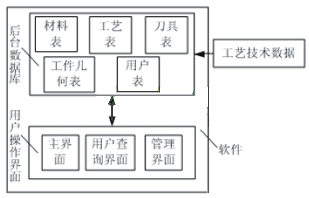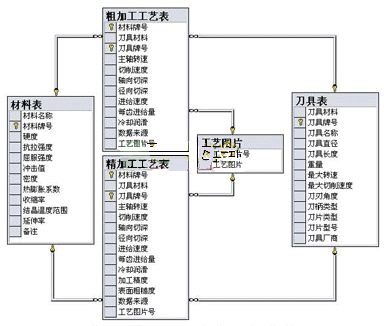High Speed ​​Machining (HSM) is one of the modern advanced manufacturing technologies. It has the advantages of high cutting efficiency, low cutting force on the workpiece, low cutting heat, low cutting forced vibration and high processing quality. Its cutting speed, feed rate and feed acceleration are increased to 5 to 10 times of ordinary speed cutting, and the technical data of machine tools, tools and cutting processes are very different. Because the grade performance of domestic workpiece materials is different from foreign countries, it is impossible to completely copy the foreign HSM process technical data. In order to give full play to the effectiveness of expensive imported HSM equipment and to maximize tool life, it is urgent to research and develop a HSM process database suitable for national conditions, and provide practical reference tools for domestic enterprises as soon as possible. The following is a database of high-speed cutting processes developed through the development of international industry-university-research cooperation.
|
1 The function and basic structure of the database system
The function of the database system is to provide process technical data query information, for the user's actual HSM reference high-speed milling processing accounts for 80% of HSM applications, so the database is currently only included in the milling process technical data.As shown in Figure 1, the database system contains two major parts of software and process technology data.
The software design adopts the current mainstream tree structure relational database and compares it with hierarchical data or network data model. It has a clear mathematical foundation, strong management functions and good operability. The software consists of two parts: the back-end database and the user interface. The former is a variety of tables for loading corresponding process technical data, including geometric information of the workpiece, which is a set of human-machine dialog boxes between the former and the user.The back-end database part of the software is developed on the SQL Server2000 platform of the relational database management system, which is easy to modify and supplement, and can be extended to an expert system. And support network remote query data information. The user interface is developed using the VB6.0 programming language. It fully supports the structured query language SQL and is easy to use for human-machine dialog operations.
The user interface is linked to the back-end database through an Open Database Connectivity (ODBC) interface developed by Microsoft. ODBC is designed according to SQL rules and can be used as a common interface between various Microsoft programming languages ​​and all database development platforms that accept SQL rules.Part of the HSM process technology data is accumulated through experimental cutting in our laboratory, and the other part is provided by Chinese cooperative enterprises participating in international cooperation projects, which is the crystallization of their many years of production practice.
2 software back-end database
In accordance with the functions specified for the database system, it is required to include the workpiece material, tool, cutting process and other data information of the HSM cutting example for future reference. Correspondingly, in the back-end database, tables such as workpiece materials, tools, processes, and process pictures need to be created to store the information, as shown in Figure 2.
|
Considering that the geometry and size of the workpiece also have a great influence on the HSM process, a process picture table is set up in the back-end database to indicate the geometric information of the workpiece corresponding to the cutting example, so that all the data information has more reference value. The process picture form is also part of the process form.
In order to accurately describe and define the material of the workpiece to be processed, in addition to knowing its name and brand as the basic mark, it is also required to give values ​​of mechanical properties such as hardness, tensile strength, yield strength, impact value, thermal expansion coefficient and elongation; The size, by affecting cutting forces and cutting heat, can have a large impact on the HSM process. Accordingly, each corresponding column is set in the workpiece material table.According to practical experience. After determining the workpiece material, selecting different tool materials and grades will decisively affect the setting of cutting parameters and other process conditions. Therefore, the tool material and grade column are arranged at the beginning of the process table. Considering the geometric parameters of the tool and the structural performance information, it is very important, and in turn, it is subject to the constraints of the workpiece geometry and processing technology. It is logically not to be juxtaposed with the process data information. A tool table is set up separately in the background database. Below the process table.
The content of the second sequence in the process table is the cutting parameter that needs to be directly set and adjusted when the HSM CNC milling machine is actually operated, that is, the spindle rotation speed, the axial cutting depth, the feed speed, and the radial cutting depth, that is, the cutting distance. Since the cutting speed is a representative process parameter of HSM, the feed per tooth of the milling cutter is also an important cutting parameter. The corresponding columns are added in the process table, and they are displayed by the back-end database to display and provide reference. In addition to this, there are also columns that describe other process conditions such as cooling and lubrication.HSM is mainly used for the processing of half-tips and tips of steel and difficult-to-cut materials, as well as the roughing and finishing of free-cutting materials such as aluminum, copper, engineering plastics and graphite. In order to balance the process diversity, the process database of the back-end database is classified according to roughing and finishing, and the latter has two columns of processing precision and surface roughness.
The last column in the process table is the process picture number for the different extraction process picture table, which links the process technical parameters to the geometric information of the workpiece being machined. In the process picture table, there are only two columns of the process picture number and the process picture. The former is linked to the process table, and the latter points to the physical address where the process picture is placed. The picture is displayed when the user calls it. In the tool table, the first two columns are tool materials and grades. Also echo the link to the process form. Then, according to the actual needs, the tool name, geometric and physical parameters, use limit parameters, composition and manufacturing suppliers are set up in more than a dozen columns, and can be increased or decreased at any time in the future.
|
Next page
Plastic Window Screen,Fiber Mosquito Net Rolls,Fiber Window Curtain
Yongwei Metal Product Co., Ltd , http://www.hswire-mesh.com


